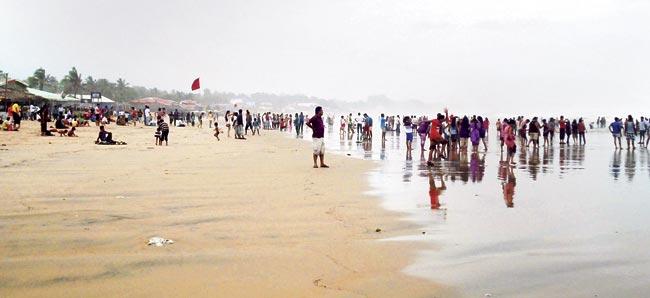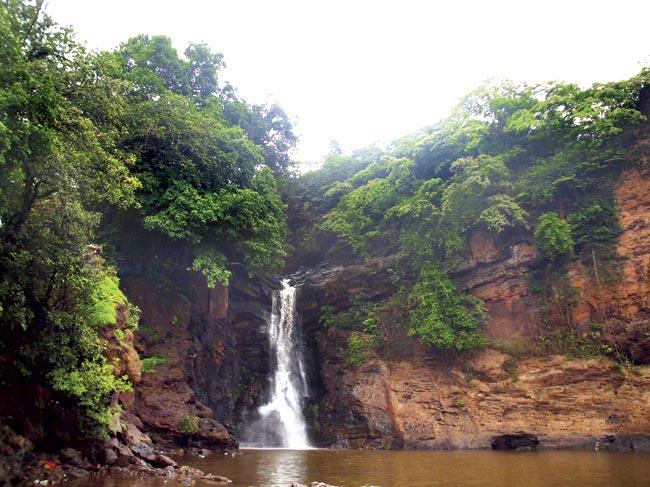Goa is re-inventing itself as a go-to place even during the monsoon, with an accent on festivals and nature's bounty for tourists

There are many who feel the best time to be in Goa is during the rains. There are fewer tourists, hotel room tariffs are lower, air fares are discounted, and the best part is Goa is at its best.
ADVERTISEMENT

A view of the Western Ghats in the rains. Pics/ Joseph Zuzarte
As Ralph DeSouza, a resort owner and spokesperson for the Travel and Tourism Association of Goa (TTAG is the apex tourism industry body in Goa), puts it, "During the monsoon you see Goa in all its colours, its culture and heritage is visible. This is the time to visit a fresh, clean and green state."
Haven when it's wet
Until recent years, there were only two tourist seasons in Goa: from October to May and the off-season from June to October when it rains. That is no longer true because of many reasons. The biggest factor which has changed things is the state government's constant promotion of Goa as a year-round destination.

The hinterlands come alive
"There have been monsoon promotions in domestic markets by way of print and electronic media. Special monsoon packages have been floated through various agents to market Goa across India. In travel marts, road shows conducted in metro cities, urban and semi-urban locales, Goa was showcased as an ideal monsoon destination," says DeSouza.
The other big reason is that tourism is the biggest industry in Goa, with around half the state's population directly or indirectly dependent on it. To expect everybody to simply shut shop during the monsoon months is clearly unrealistic. So while there are many susegad (easy-going) Goans who simply put up their feet and relax during the rains, there are also many who don't. Many resorts, hotels, guest-houses, restaurants and other businesses which earlier used to close down for the 'off-season', now stay open because the tourists still keep coming, though in reduced numbers.

Baga beach with tourists forced to stay away from the rough sea during the monsoons
First showers
Those who do come, though, are usually stunned because with the first rains, the entire state turns green, with lush fields, burbling brooks, and wild flowers. If you're adventurous enough to wander off the coastal areas and venture into Goa's hinterland, as the interior areas are known, there are roadside waterfalls in the undulating mountains, barely an hour's drive from the beaches.
But there's one big difference between the 'season' and the 'off-season': no beach shacks and no foreign tourists. Consequently, there are no 'bikini' babes lounging around on beach beds, one of Goa's more famed attractions for domestic tourists. Many beaches also get eroded by the monsoon currents and bathing or swimming in the sea is completely banned as it is rough. Not that that really matters as the freshness of the landscape takes one's breath away.

Waterfalls are all around during the rains in Goa
Michael Lobo, owner of resorts, restaurants and other tourism businesses, says, "There is a lot of excitement in Goa during the monsoon. People come to enjoy the rains, and everything is beautiful, everything is green, there is water flowing everywhere, small ponds are formed and people swim in them.
In the third week of June we have the Sao Joao festival (Feast of St John the Baptist) which is celebrated throughout Goa by people jumping in the wells." Lobo is MLA of Calangute constituency which has more than half of all the seasonal beach shacks in Goa, and the highest concentration of modern resorts and also the most popular beach stretch, Candolim-Calangute-Baga.
Viva, Sao Joao
The 'Sao Joao' festival is the first big monsoon festival in Goa. Still largely a festival of the people, it has now also become part of the tourism industry, with many resorts holding 'Sao Joao Bashes and Splashes' in their swimming pools.
Locals though celebrate it on the feast day, June 24. Young and old, men and women, form groups and go around jumping into the neighbourhood wells, to loud cries of "Viva, San Joao!" Those who jump get to wear a crown of flowers called the kopel. A few minutes of raucous splashing around, and everybody moves to the next well. It's a tradition unique to Goa.
Another popular festival which has not yet been completely 'touristified', is the 'Sangod' festival, which is Goa's very own boat festival. Celebrated in only a handful of villages, 'Sangod' (which, loosely translated, means 'togetherness') is a festival of the fishing community during which a few small fishing boats are roped together and a stage with the backdrop of a chapel is erected on them. A variety entertainment programme is then staged while the boats move up and down the river, entertaining groups of villagers who gather at different spots on the banks.
There are other festivals which unfold as the monsoon progresses, like 'Bonderam' (festival of flags), which is much like the Carnival and is only celebrated on the island of Divar, in central Goa. In fact, it has become the tourism industry and government's strategy to turn these festivals into tourist attractions.
Says DeSouza, "We need to have a calendar of events where Goa will host at least two mega crowd-drawing festivals in the rains. Local festivals like 'San Joao' and 'Bonderam', besides others must be included. A music event like 'Goa Rocks in the Rains' is an idea that will find place in the calendar. Goa participated in the Arabian Travel Mart and was promoted not only as a beach destination but as an ideal place for monsoon holidays."
Festivals galore
So during the 'season', there are music festivals like Sunburn and Supersonic, bike festivals, wine festivals, Carnival, Easter and many others, while the monsoon will now have more festivals, in addition to the traditional festivals. "The western part of Goa has benefitted from tourism, and now we're taking tourism into the eastern parts of Goa," says Goa Tourism Minister Dilip Parulekar.
"The monsoon is an opportunity as the eastern side is very beautiful when it rains. We're creating awareness about the mountains and have been promoting Goa as a monsoon destination with adventure sports like river rafting and also as an eco-tourism and agri-tourism destination.
It's also being promoted as a great time for honeymoon vacations," he says. Inland water bodies like Mayem Lake (near Bicholim in North Goa) already have various boat rides, while Selaulim Dam (South Goa) is also being developed on similar lines so tourists can have boat rides during the monsoon, and visit the hinterland.
A top Goa Tourism official, requesting anonymity, says, "To be candid, we cannot get foreign charters during the monsoon as Goa has been positioned as a tropical beach destination. Foreign charters from Europe come here when it is winter there, because they love the sun. So we're only targeting domestic tourists during the monsoon, especially in the northern plains which have a hot climate.
Arrivals are up by 8 per cent this June (compared with last year), and many hotels in the beach belt have even reported occupancy of 80 per cent. We're promoting Goa as a destination for eco-tourism, wellness and nature-based tourism."
The biggest attraction during the monsoon is the lush Goan countryside which comes alive, especially the thickly-forested Western Ghats. Barely an hour's drive away from the touristy coastal areas, a visit to Goa's hinterlands, can be a refreshing experience. Many seasonal waterfalls also come alive at this time, and though many are deep in the jungles and involve a lot of trekking, there are many others which are right by the roadside.
"We are pushing to make hinterland tourism a reality," says DeSouza. "We have over 350 kms of navigable rivers and the best way to visit the hinterland is through waterways. Our wildlife sanctuaries and eco tracks on the foothills of the Western Ghats need to be better exposed to visitors and tourism facilities need to be created," he adds.
Nature's best
However, there is also an increased awareness that the pristine forests need to be treated with care, and should not go the way of the beach-belt which has seen a proliferation of concrete resorts. "We don't need resorts or hotels in the hinterland as Goa is a small state with just 45 minutes to an hour's drive from the coast to the interior.
What would be more apt is accommodation in the form of comfortable tents, log cabins or mud huts which blend with the rural setting," says DeSouza. "A long standing need is proper tourism infrastructure and connectivity to places of interest. We need to create facilities to cover our bare requirements which again respect nature and the village landscape. We should avoid concretisation of our hinterland at all costs as this is where the soul of Goa resides."
Most of the Western Ghat areas in Goa are protected areas with colourful tropical flora and fauna. A drive through them, specially as you reach higher levels, throws up stunning vistas, and you literally end up in the clouds on Goa's border with Karnataka at Chorla Ghat and Mollem. In a bid to attract more tourists, the Goa Tourism Development Corporation (GTDC) started white water rafting in the north-eastern corner on the Mhadei River last year.
"I never knew that such areas existed in Goa. More people need to be told about these beautiful forest areas," says Jean-Paul Scherer, the Swiss general manager of a five-star resort who first discovered the hinterland when he went river rafting last year. The Mineral Foundation of Goa (started as part of corporate social responsibility by mining companies) has this year started a 'pilot project' for 'home stays' in local village homes in the Netravalli forest area in South Goa which has some of the most pristine rain forests.
Visitors will get to sample local food, but no alcohol will be served, and you can only stay for a couple of days. "Lots more can be done as we need focused and tailor-made monsoon promotions to market our raindrops and capture true rural Goa in our promotions," says DeSouza.
However, there are some things which cannot be changed. Because the beaches get eroded, there are no beach shacks between June and October. Also, water sports too are banned in this period as the sea turns rough. As Johnny D'Souza, a water sports operator who also runs a beach shack during the season says cheerily, "We have to sit idle." In true Goan susegad style, many welcome the break after the hectic 'season'.
Of course, there's also the small matter of torrential rain, at times for days on end, also casting a wet blanket, and with a 60-day ban on fishing by trawlers from June to July-end, there's also a shortage of fresh seafood. But, hey, you can't have it all.
 Subscribe today by clicking the link and stay updated with the latest news!" Click here!
Subscribe today by clicking the link and stay updated with the latest news!" Click here!






